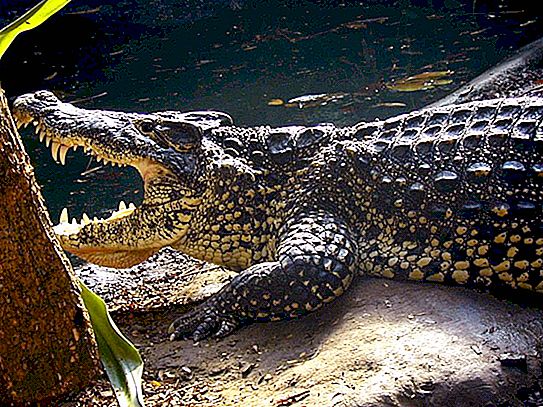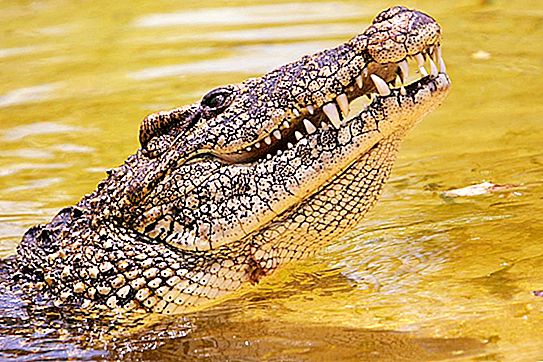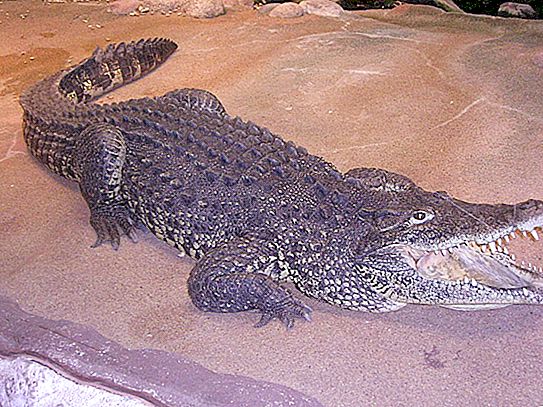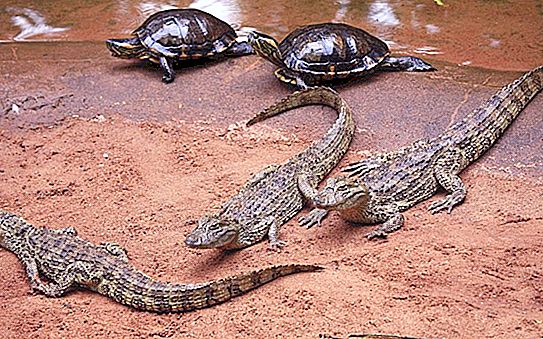A Cuban crocodile, crocodylus rhombifer, as scientists call it, lives in a limited area. It is impossible to meet this reptile outside the Greater Antilles, of course, if you do not take into account terrariums and zoos.
This variety of crocodiles has a number of interesting differences from their relatives living in other parts of the world. This is explained by the separate development of this species of reptiles.
What does this crocodile look like?
The Cuban or pearl crocodile, as it is often called, differs externally from the rest. The main features that characterize the Cuban, in which differences are made with other crocodiles, are:
- skin covered with large scaly layers on the limbs;
- long legs with great strength;
- bright colors in coloring;
- wavy pattern resembling a pearl shell;
- light, plain belly, contrasting with the back.
The face of the Cubans is wide, and compared with other types of crocodiles - quite short. Behind the line of eyes of these reptiles there is a bright light scallop.

Their teeth are relatively few, from 66 to 68 pieces. The structure of the jaws and the teeth themselves is curious. The mouth is arranged so that the teeth located closer to its base are several times wider and shorter than those located in front. Such a mouth device allows the Cuban to bite and crush the shells of turtles, which make up his main diet, without straining.
Where does this crocodile live?
Another nuance that distinguishes the Cuban crocodile from others is distribution. This reptile has one of the most narrowed habitats; it now lives in only two places, on the islands of Huventud and Cuba.
Huventud Island is the second largest in the Los Canarreos archipelago and is located 50 kilometers south of the Cuban coast. Until 1978, this area was called Isla de Pinos, which, translated into Russian, means - the island of Pines. Crocodiles live in its boggy part.
In Cuba, reptiles can be found within the conservation area located in the province of Matanzas, bordering on the west with Havana. Cubans live in a swamp, the total area of which exceeds 4354 square kilometers. It is called the Zapata swamp, just like the entire peninsula on which the conservation area is located.

Scientists find the ancient remains of this species of crocodiles in the Cayman Islands and the Bahamas, but living individuals are not found there.
How big is this crocodile?
The Cuban crocodile is not significant in size, it is far from a giant. The average size of the reptile masculine is modest enough:
- body length from 2 to 2.3 meters;
- weight is about 40 kilograms.
The Guinness Book of Records mentions an individual with a body length of 2 meters and 74 centimeters. The petrified remains of these crocodiles, which scientists find, are much larger. For example, skulls with a length of more than 66 centimeters are found, which allows us to conclude that the body length exceeds five meters.
However, the Cubans living now in the Zapata swamp not only do not reach the level of the size of their fossil ancestors, but also, on the contrary, often turn out to be smaller than the average standards accepted by scientists.

Female representatives are smaller than a Cuban crocodile male. The difference in size is noticeable externally, the average length of the female is 1.4-1.5 meters.
How does this crocodile live?
The Cuban crocodile lifestyle is quite active. This animal is very aggressive, even for a reptile of this type. They prefer to live in fresh water, but can tolerate a brackish environment.
In the way the Cuban crocodile lives, there is also a nuance that distinguishes it from relatives. The Cuban spends most of his time not in water, but on land. This species of reptiles briskly moves without touching the surface of the abdomen and is quite capable of speeds of 17 km / h. The Cuban, in principle, is very active, he briskly pursues prey, like any land predator, and is even able to bounce low. This behavior is unique to a crocodile.
What is the aggressiveness?
Reptile aggression is expressed in its desire to dominate other species. For example, when kept together in zoos, Cubans select food and in every possible way oppress territorially other crocodiles.
In the case of intersection in the wild natural environment with the sharp-headed reptiles, which have much larger dimensions, the Cubans, not really bothering, displace them from the freshwater environment. Of course, do not disdain and select the extracted food.

Despite the desire for a dominant role in their habitat, this type of reptile is quite social within its species. Cubans are able to unite, are loyal to their own relatives, and scientists believe that this type of crocodile is the most intelligent of the living.
What do these crocodiles eat?
A small Cuban crocodile eats crustaceans, mollusks and everything that can be found. As they grow older, the reptile's diet changes. The basis of the Cuban food is caimans and turtles, but not only they make up its diet.

Adult crocodile eats:
- fish
- huti is a species of rodent that lives in Cuba;
- wild pigs;
- dogs that are close to the place of hunting;
- shellfish.
The Cuban can hunt other reptiles, however, as well as other mammals. Crocodiles do not depart far from their habitat, so their diet forms what appears to be close.




